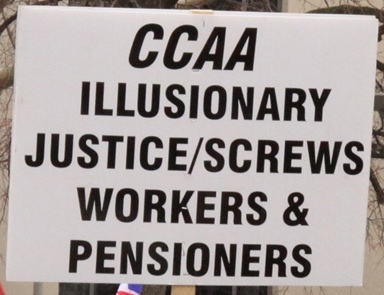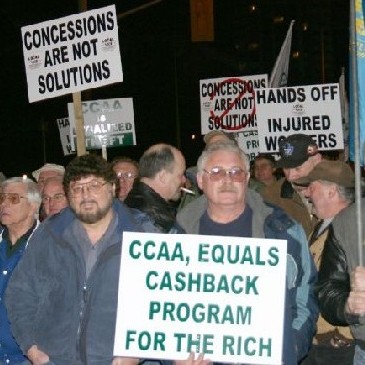|
March 10, 2016
CCAA -- Powerful Private Interests
Manipulate the Court
Don't Let U.S. Steel Abscond with
Billions! Keep Stelco Producing!
PDF

CCAA
--
Powerful
Private
Interests
Manipulate
the
Court
• Don't Let U.S. Steel Abscond with Billions!
Keep Stelco Producing!
Coming Event
• Hamilton Town Hall Meeting Against Hospital
Cuts, March 29
CCAA -- Powerful Private Interests
Manipulate the Court
Don't Let U.S. Steel Abscond with Billions!
Keep Stelco Producing!
People are amazed that a judge can rule so one-sidedly
in favour of a company. CCAA Justice Wilton-Siegel decreed that U.S.
Steel's equity interest in the former Stelco steelworks, gained through
an ownership purchase in 2007 and increased with added
injections of cash, is a debt to itself. This is significant, as
Wilton-Siegel's decree under the authority of the Companies'
Creditors Arrangement Act (CCAA) puts U.S. Steel in line to
seize all
of the money received when the Stelco steelworks are
sold.
The people's amazement is well founded, as the decree
makes no sense. But upon reflection, this is not the first time such an
absurd ruling under CCAA has astounded almost everyone. In 2004, those
who controlled Stelco at the time declared a "liquidity
crisis" and a certain Justice Farley agreed to put the company under
CCAA bankruptcy protection. The "liquidity crisis" soon
proved to be a total farce, for immediately upon entering CCAA, Stelco
managed two of its most profitable quarters. Of course, this did not
stop Justice Farley from pursuing the
CCAA fraud until 2006, when everything fell into place for
a big score by a handful of parasites, including the
debtor-in-possession Brookfield who had gained control of Stelco while
under
bankruptcy protection. The CCAA farce played out at the expense of
steelworkers, retirees, salaried employees, shareholders, other
creditors, the economy and surrounding community. The CCAA fraud did
not solve any problems economic or otherwise but instead
weakened Stelco allowing U.S. Steel to move in for a takeover one year
later.
The Companies' Creditors Arrangement Act
The federal government introduced the CCAA during the
economic crisis of the 1930s but it did not take off as a tool of
powerful private interests until the 1980s, when the ruling imperialist
elite unleashed the anti-social offensive to smash up all
the arrangements from the post war period.
The CCAA court gained momentum allowing the powerful
private interests controlling monopolies to liquidate their holdings
with either minimal damage to themselves or even making big scores
while attacking the interests of their workers, retirees,
creditors, the community and economy. Monopolies that have used CCAA to
further their private interests in opposition to the
public interest include AbitibiBowater, Air Canada, CanWest, Kitco,
Nortel Networks, Quebecor World, Sino-Forest Corporation,
Stelco, and Target Canada amongst others.
In explanation of the CCAA, legal opinion suggests that
its approach is not "rules based" but rather pragmatic, which
according to the Supreme Court of Canada "provides a more discretionary
approach that is remedial in nature, which therefore must
be broadly construed."
The CCAA stated goal is "to
facilitate compromises and arrangements between companies and their
creditors." People note that
the goal is not to solve the economic problems plaguing the company and
sector and guarantee the rights and well-being of the
workers and others involved. The aim opens up all previous arrangements
to possible attack or "compromise" including even the rule
of law governing pensions etc, and long-held and negotiated collective
agreements. The stated CCAA goal is meant to negate any
solutions to problems that may lead to a new pro-social direction for
the company or sector and serve the public interest.
 In most instances, the
workers and retirees who through
their work have produced all the value connected with the company
under CCAA and whose lives depend on that work and value are reduced to
"creditors" who may or may not be secured and compensated.
The "creditors" are subject to the CCAA court's "broad discretionary
approach and powers" to arrive at the declared goal. As U.S.
pragmatism says, "Whatever works to meet the goal must be good or at
least permissible." In most instances, the
workers and retirees who through
their work have produced all the value connected with the company
under CCAA and whose lives depend on that work and value are reduced to
"creditors" who may or may not be secured and compensated.
The "creditors" are subject to the CCAA court's "broad discretionary
approach and powers" to arrive at the declared goal. As U.S.
pragmatism says, "Whatever works to meet the goal must be good or at
least permissible."
Once the pragmatic approach is accepted, the rule of
law, objectivity of consideration, a "rules based approach" along with
modern principles and rights are thrown out the window. Whatever
works means in practice that the most powerful private
interests prevail as they set the goal. Needless to say, this takes
Canada back to the medieval period when the ruling aristocracy
simply declared what was in their private interests to be the accepted
outcome of any dispute. During the depths of medieval
depravity, one example of justice to terrorize the people and force
them to obey the autocrats was to throw an accused in the
river: if they drowned they were judged innocent; if they survived and
made it to shore, they were judged guilty and executed.
Of course with the CCAA, more appropriate language is
employed that softens the approach but the result is the same as in
medieval times. The CCAA states in s. 11 that a court may "make
any order that it considers appropriate in the
circumstances" to meet the goal.
This was glaringly obvious during the 2004-06 Stelco
CCAA case under Justice Farley when people noted that he seemed to be
ruling by the seat of his pants, just making things up as he went along
and decreeing any order he considered appropriate to meet
the private interests of those in control and the goal they had set.
Wilton-Siegel is following Farley's notorious example.
His decree declaring as debt to itself the money U.S. Steel used
to purchase Stelco and any additional amounts disguised as loans is
right up there with anything Farley ever did. Many have noted
that a number of U.S. Steel's so-called loans to its wholly-owned
subsidiary in Canada were made after CCAA bankruptcy protection
had already been decided as the way to go. They suggest that the
existence of these fairly recent so-called "revolver loans" to
itself is proof of a criminal conspiracy well thought out in advance in
preparation to enter CCAA. A conspiracy would involve
using CCAA to avoid making the pension plans whole, absconding with the
best customers, not repaying the loan to Ontario and not
paying post-retirement benefits and municipal taxes, aside from the big
bonus of having the $2.2 billion equity investment
returned to the conspirators' coffers.
|

Hamilton Demonstration during first round of Stelco CCAA, February 27,
2004
|
People realize that CCAA is not like a court of law
either a criminal or commercial court. In a criminal case for example,
someone is accused of murder and the prosecutor presents evidence to
prove the accused is guilty beyond a reasonable doubt. The
defence presents evidence to refute the prosecutor's case and prove the
accused is innocent. The judgement rests on the evidence
presented.
That is not the scenario with the CCAA. The outcome has
already been decided according to the broad aim of the CCAA and the
narrow goal of the applicant's private interests as set out in their
factum. The court process is merely to justify arriving at
the goal. The powerful private interests that bring their case before
the CCAA court have already decided the goal in advance,
which is found in their presentation of a position within a court
factum.
You can argue all you want and spend millions on
lawyers but that will not change the outcome because essentially the
CCAA
process is merely to justify an outcome that has already been decided.
Only broad exposure of the fraud in the court of public
opinion will influence the outcome. Local 1005 found in the 2004-06
Stelco CCAA fraud that the best way to defend their pensions
and their collective agreements was to refuse to participate. The
steelworkers went to the court of public opinion and found broad
support in the community for their position that the CCAA was a fraud
and the CCAA court had no business tampering or interfering
with their pensions and collective agreements that existed in law.
Local 1005 and others pointed out forcefully that the
CCAA fraud would not lead to solving any problems at Stelco and would
not assist in finding a direction for the Canadian steel sector that
would put it on its feet. Stelco was badly wounded by the
CCAA when assets were stripped and hundreds of millions of dollars were
taken from the company by the parasites who had seized
control. They sold the "new" Stelco to U.S. Steel for a big score of
which none went into the pension plans or towards any renewal
of the steelworks. U.S. Steel handed the parasites the money so that it
could eventually eliminate a competing Canadian steel
company especially given the economic crisis that erupted soon after in
2008.
Now U.S. Steel is using CCAA to declare its purchase
and destruction of Stelco as a debt to itself so that it can scurry
back
to the U.S. with its most lucrative customers in tow and $2.2 billion
in its pocket, all the while hoping that it has injured
Stelco to the point it can no longer produce and compete.
The people led by steelworkers are determined not to
allow this to happen and vow to defeat this CCAA fraud and keep Stelco
producing with a new direction that addresses its problems and those of
Canada's steel sector.
Down with the CCAA Fraud!
Keep Stelco Producing!
Note
The CCAA is not unique within the U.S.-led imperialist
system of states. The global monopolies use a similar system to serve
their narrow private interests in the U.S. and UK. The CCAA clone in
the U.S. is called Chapter 11, and in the UK, Company
Voluntary Arrangements (CVAs).

Coming Event
Hamilton Town Hall Meeting Against
Hospital Cuts, March 29
Tuesday,
March
29
--
7:00
pm
City Hall Council Chambers, 71 Main St. W.
Organized by Hamilton
Health Coalition



PREVIOUS
ISSUES | HOME
Read The Marxist-Leninist
Daily
Website: www.cpcml.ca
Email: editor@cpcml.ca
|





